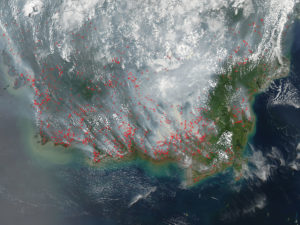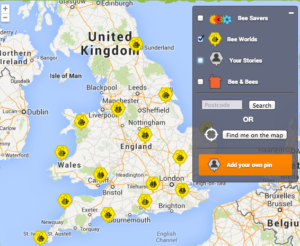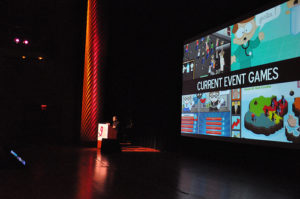A new prototype out of the Greenpeace Innovation Lab may be the key to unlocking the future of online activism. It’s a game that allows members of the public to track illegal deforestation in Argentina using real satellite images. Rather than clicking to sign an online petition, liking a post on Facebook or donating to an organization, this new game shifts the balance of power so that people can participate in a campaign on a deeper level.
Players earn scores and interact with a community of like-minded people, while bringing attention to a vital environmental issue.
“We want our supporters to be the hero of the story and enable them to campaign together with the community, together with us,” explains Ingo Boltz, manager of the Innovation Lab.
“We’re getting away from this elitist approach (that says) we know it all, we do the actions, you just donate money and we’ll take care of the rest. “So the question is, how do you actually do that?” The interactive game Greenpeace Guardianes — Spanish for “guardians” — launched as the kick-off to a Greenpeace campaign to stop illegal deforestation in the Salta province of northern Argentina in late January. The campaign targets the government of Salta for approving the recategorization of protected areas into unprotected ones, despite the Environmental Protection of Native Forests Act, a 2007 law that vows to protect endangered forest in the region.
Eyes on the Forest: Tracking Illegal Logging One Click at a Time
Organizers integrated Greenpeace Guardianes into the larger deforestation campaign, asking supporters to help co-create a complete map of Salta’s forestland and have fun in the process. To date, more than 23,500 registered players have collectively classified 530 km2 of forestland as illegally logged.
After an easy tutorial that explains to players what they must look for, they can view satellite images provided for free from NASA, comparing what a parcel of land looked like in 2008 to what it looks like today. If it appears companies are logging illegally, the player marks an alert on the plot in question. To avoid false positives, 30 other players must verify such an alert, and after that it passes for final confirmation to a group of Greenpeace campaigners or trained volunteers. Only then does the alert become “official,” enabling players to create a public denouncement — a form containing information about the specific plot of land that the player can use to write to the corresponding governor’s office, or publish a denouncement on Facebook or Twitter.
Verification by Greenpeace staff can become a bottleneck when thousands of people play the game. To remediate this, Innovation Lab is currently collecting data on the accuracy of player verifications. If the player crowd turns out to be sufficiently accurate, a semi-automatic verification system will be implemented that only flags “uncertain” alerts (on which the community opinion is divided) for Greenpeace authorization. Alerts with a high degree of consensus by players will be auto-approved.
Both reporting new plots with illegal deforestation and verifying the plots of others are ways for players to increase their score.

If a plot is alerted for illegal deforestation, it must be verified by 30 other players before players can launch public denouncements aimed at political leaders involved. The orange plots in this screenshot have been verified.
“We’re still trying to figure out which of the two motivations is stronger,” Ingo explains, in terms of individual or collective motivations. “Right now, there is a bit more emphasis on the individual objective of becoming the highest scoring player. But I think one of the things we’ll emphasize more, depending on the feedback from the players, is how close the player community is to mapping the entire area.”
Still a work in progress, the Innovation Lab team is continually adapting, improving and refining the game as they gain insights into human motivation.
“We probably overestimated the motivation of score a little bit,” Ingo says.
When the team prototyped the game in the Greenpeace Argentina office, individual score comparison was a high player motivator, he says. But they came to realize this motivation was dependent upon how well players know their competitors.
“Now that we have tens of thousands of players, you don’t necessarily know the people who are listed as near you in the high score ranking. It becomes a little abstract,” Ingo says.

A public denouncement comparing current and past satellite images provides an opportunity for players to send an e-mail to the corresponding government official. Players can also make public denouncements via Facebook and Twitter.
“One of the things we’d like to do once we find the time and resources is to list scores relative to your friends’ community. So you would not get lost in this general 25,000 person list, but it would show you where you are in comparison to your Facebook friends,” he says.
Why a Game? People Like Solutions Over Protests
In his research, Ingo came upon citizen science, a pioneering concept that aims to harness the power of idle computing for the benefit of scientific knowledge. An early example is a game called Foldit, which invites players to contribute to building the scientific knowledge base of protein folding. Protein folding plays a role in things like disease and plants as fuel. “If we could do something like this, then people could actually help us with campaigns by putting in more work than signing a petition, for example,” he says.

Guardianes players can zoom between satellite images from 2008 and the most recent images from this year.
“It’s also more engaging because they invest more time. So, our assumption is that they’ll be more invested in the project. Maybe they’ll be willing to do other (tasks) as well.” Before the team developed the game, forest campaigning often entailed hiring a plane that would fly over protected areas. With the help of tips and intelligence about the likely locations of bulldozers, those planes had to look for a needle in a haystack. Thinking outside of the boundaries of a traditional campaign, the team developed the game, which fosters more engaging community participation.
Value-based segmentation, a theory that groups people roughly by what they believe in, also influenced game development. The theory divides people up by what motivates them, rather than typical demographics like age, sex or social class. One category is “prospectors,” described as having an unmet need for success.
“Argentina and India have a lot of ‘prospectors’ because they’re developing, but they’re already at a certain level. So a lot of people are busy with getting better and accumulating stuff,” Ingo says. “We’re trying to talk to people who aren’t usually talked to. People who like solutions more than simple protest. People who like to do fun stuff.”
You Can’t Be Grand Theft Auto
As players busily map deforestation, they are occasionally invited to “find the jaguar.” This mini game, built into the larger game, notifies players that a jaguar has been spotted and the first player to find it gains 20,000 points. To be clear, there is no actual jaguar being tracked by the satellite images — this happens purely for entertainment purposes. During the game’s development process, some users suggested introducing more fun elements in the game to retain a certain pace of entertainment and attention.

In Salta, Argentina, forest protection laws designate certain areas as red zones — where deforestation is illegal and the land must be treated on par to a national park.
“It would be great to think that eventually we would get people who don’t really care about the environment, who are indifferent towards Greenpeace, but they’re really entertained by our game and are playing it just for fun,” Ingo says.
“This idea of going beyond our choir is useful and the right thing to do but it has limits,” he adds, referring to the notion of using campaigns to reach people outside of the group of typical campaign supporters.
A few years ago, the team tried to launch a different game which did not launch. Though it wasn’t successful, they learned several lessons on gaming.
“If you’re competing for the attention of people who just want to be entertained, there’s no way that with our budgets and our development horizons that we can compete. If someone just wants to be entertained, they can play Grand Theft Auto 5 or the latest Playstation 3 game, and that’s always going to be so much more fun.”
Ingo says they spent roughly $20,000 developing Guardianes. In addition to budget constraints, Greenpeace games will always be limited by the need to strike a balance between entertainment and usefulness to the mission.
“Otherwise why are we doing this?” Ingo says. “If you have to get the balance right, you always have to compromise on how much fun it can be — beyond just looking at budget. Grand Theft Auto costs tens of millions of dollars to make. They have teams of hundreds of people — scriptwriters, designers, musicians.
“In terms of pure entertainment, we will not be able to compete. But what we can do is involve people who are interested in us in becoming part of the solution by providing data, by working, instead of just signing a petition and feeling good about themselves for five seconds. Making that process of working with us more entertaining,” he says.
‘Hacking’ Greenpeace Guardianes For Other Campaigns
Ingo recently presented Guardianes at the Greenpeace Digital Mobilization Skillshare in Umbria, which included people doing digital work across many departments of the organization.
“People loved it,” he says, adding others were interested in replication it for campaigns with a different focus. They proceeded to have a session on “hacking Guardianes” in order to take some of the same principles but apply them to different campaigns.
“A lot of ideas came up,” he says, “from monitoring ocean acidity to show where reefs are dying, to staking out glaciers. There’s a lot of potential in this. We’re only just getting started.
“Judging by the initial reception of this kind of activism, we’ll see a lot more of this.”
Stay connected: @ingoboltz. More about the game: http://guardianes.greenpeace.org.ar/
Related posts: Games summit taps developers’ passion for saving the planet
Ready to become an Arctic Defender?
Do you have an innovation in mobilisation and people-powered campaigns? Share it with Mob Lab by contacting moblab@greenpeace.org.
Categories:
tech, tools and tactics



